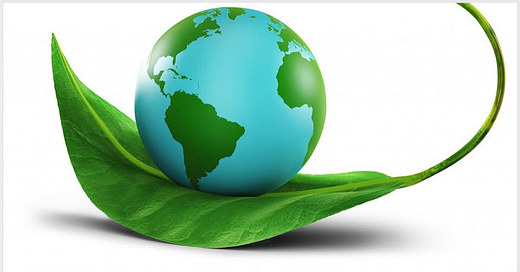This month's theme is An Exceedingly Good Land, chosen from the Torah Portion Numbers 14:7, our June reading from the Eco Bible: An Ecological Commentary, Vol. 2.
Week 4 Mangroves and the secret to saving everything
Mangrove forests are exceptionally effective carbon sinks, storing more carbon per unit area than even rainforests. They achieve this by trapping and storing significant amounts of carbon dioxide (CO2) in their soils and releasing it slowly into coastal waters. This process, known as blue carbon, plays a crucial role in mitigating climate change. Carbon stored in mangrove soils can be hundreds or even thousands of years old, making them a reliable and long-term carbon sink. These forests play a vital role in protecting coastlines from erosion and flooding, and they provide habitats for diverse and often endangered species. It can be argued that the mangrove tree is the most important tree on the planet, not only because it helps control the planet’s temperatures, but, as 40% of world’s people live along coastlines, rising sea levels endanger these populations and their livelihoods. As little as 50 years ago these coastal areas were fished and farmed in a sustainable manner. But, as author Kevin Bales says: “All that changed when seafood went global.” Read an excerpt from his important book, Blood and Earth: Ecocide, Modern Slavery, and the Secret to Saving the World at this link, How Hunger for Shrimp and Slavery Destroy Mangroves.
Learn more about mangroves and blue carbon here: Coastal Blue Carbon
Kevin Bales is an international expert on human slavery and human trafficking, and I was privileged to work directly with him a few years ago, when he assisted me in putting together a program on the topic and its impact on the environment for Zonta and our local trafficking task force, and we appeared together on a local radio program. Professor Bales never considered himself to be an advocate for the environment, but now we know, thanks to his research for Blood and Earth, that the problems of human slavery and environmental destruction are intimately linked, and on a global scale. I had first learned about his work on NPR, around the same time as the Laudato Si’ had been first published.
Listen to that program here: Today's Slaves Often Work For Enterprises That Destroy The Environment
Kevin Bales first began linking slavery and environmental issues when he realized: “What if slavery and climate change were tied together? What if we were paying for this deadly combination? What if climate change was driving people toward slavery? What if a way to fight global warming was to free slaves?” Read more here: I was missing something important.
How many slaves work for you? There are many online surveys. Bottom line: The number is probably around 55. The Slavery Footprint website provides a way to estimate an individual's "slavery footprint" by assessing the products they use and their potential links to forced labor. The 2023 Global Slavery Index estimated that 1.1 million people were living in modern slavery in the U.S. in 2021 and that number includes farm labor and sex trafficking. The 2021 Global Estimates indicate there are 49.6 million people living in situations of modern slavery on any given day, either forced to work against their will or in a marriage that they were forced into. Whether you own jewelry, use electronics, or eat seafood (or none of the above), chances are that your purchasing and lifestyle decisions involve modern slavery and damage the environment.
I urge you all to read Kevin Bales’ book, Blood and Earth, and learn more about his work! Explore his website at kevinbales.net! And I hope you’ll join the conversation this Thursday, June 26!
Links:
2 https://oceanservice.noaa.gov/ecosystems/coastal-blue-carbon/
4 http://www.kevinbales.net/fye-essay.html
June 2025
Week 1 Eco Bible, Vol. 2 (Numbers 14:7)
Week 2 Laudato Si’ (Sections 10-13)
Week 3 Many Voices: Japanese culture and Shinto
Week 4 Creation Care: Mangroves and the secret to saving everything
May 2025
Week 1 Eco Bible, Vol. 2 (Leviticus 19:9-10)
Week 2 Laudato Si’ (Sections 1-3)
Week 3 Many Voices: Focus on the Bahá’í faith.)
Week 4 Creation Care: Carl Sagan and the Pale Blue Dot
Week 5 Creation Care: St. Francis of Assisi and the Canticle of the Sun
Blessings,
Liz
Eco Bible: An Ecological Commentary
Vol. 1 ©2020 Vol. 2 ©2021
The Interfaith Center for Sustainable Development
Authors: Rabbi Yonatan Neril & Rabbi Leo Dee
Encyclical Letter Laudato Si’: On Care For Our Common Home
©2015 Libreria Editrice Vaticana Author: Pope Francis
🌿 Meeting Details:
Date: Thursday, June 26, 2025
Time:
7-7:30 PM in Israel
12-12:30 PM EDT/EST
10-10:30 AM MST/MDT
9-9:30 AM PDT/PST
Zoom Link: Join Here
Password: creation
Invite friends to sign up via this link: https://tinyurl.com/interfaithecology
Follow us on Facebook: https://tinyurl.com/LaudatoSi-Facebook



